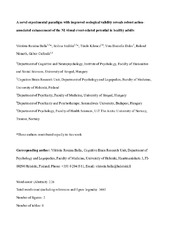A novel experimental paradigm with improved ecological validity reveals robust action-associated enhancement of the N1 visual event-related potential in healthy adults
Permanent lenke
https://hdl.handle.net/10037/16702Dato
2019-11-11Type
Journal articleTidsskriftartikkel
Peer reviewed
Forfatter
Balla, Viktória Roxána; Szalóki, Szilvia; Kilencz, Tünde; Dalos, Vera Daniella; Németh, Roland; Csifcsak, GaborSammendrag
The association between an action and its sensory consequence has been linked to our sense of agency (SoA). While ecological validity is crucial in investigating such a complex phenomenon, previous paradigms focusing on the cortical analysis of movement-related images used simplified experimental protocols. Here, we examined the influence of action-associated predictive processes on visual event-related potentials (ERPs) in a paradigm that models everyday actions more precisely, using a commercial gesture control device, ecological stimuli depicting a human hand and a behavioural training to reinforce the sense of control over action outcomes. We assessed whether a more natural setup would result in robust ERP modifications following self-initiated movements relative to passive viewing of the same images. We found no compelling evidence for amplitude modulation for the early occipital C1 and P1 components. Crucially, we observed strong action-associated amplitude enhancement for the posterior N1, an effect that was not present in our previous study that relied on conventional button-presses. We propose that the N1 effect in our ecologically more valid paradigm can either reflect stronger attentional amplification of domain-specific visual processes following self-initiated actions, or indicate that sensory predictions in the visual N1 latency range manifest in larger (rather than reduced) ERPs. Overall, our novel approach utilizing a gesture-control device can be a potent tool for investigating the behavioural and neural manifestations of SoA in the visual modality.
Beskrivelse
Accepted manuscript version, licensed CC BY-NC-ND 4.0. Final version published in Behavioural Brain Research, 112353, is avaialble at https://doi.org/10.1016/j.bbr.2019.112353.


 English
English norsk
norsk